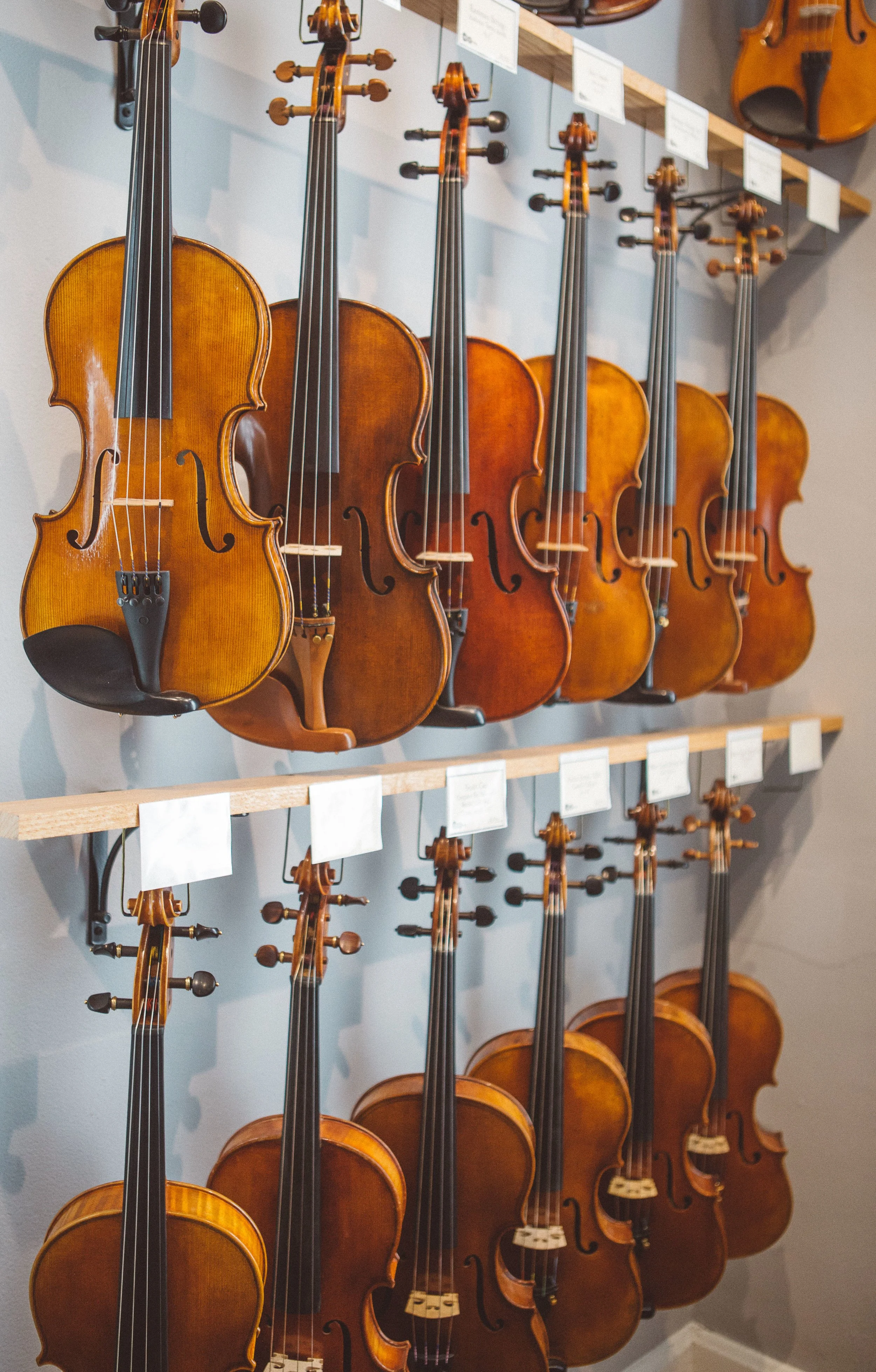CHINREST YES OR NO CHINREST
The use of a chinrest or shoulder rest while playing the violin is a topic much debated among violin players. While some violinists swear by these accessories as a means of comfort and stability, others argue that they can actually detract from the sound quality of the instrument. In this article, I’ll explore the history of these rests, the pros and cons of playing without them and tips for finding the right rest for your playing style. Whether you’re a seasoned professional or just starting out, this article will give you some valuable insights into the world of playing the violin without a chinrest or shoulder rest.
The history of chinrests and shoulder rests
The chinrest is a component that is usually attached to the lower part of the violin to provide a comfortable support for the player’s chin. Proponents of the chinrest argue that it helps improve playing posture and reduces the likelihood of cramps, discomfort and injury. The chinrest is an invention that dates back to the early 1800s, but it wasn’t until the early 1900s that it became standard for most violinists.
Louis Spohr, a German composer and violinist, is credited with inventing the chinrest in 1820. Although his early design was made of ivory, it was eventually improved, leading to the use of materials such as ebony, rosewood or plastic. After Spohr’s invention, players were slow to adopt the chinrest. It took around a century for the chinrest to become widespread. By the late 19th and early 20th centuries, the chinrest had become an integral part of the violin design.
The shoulder rest is a pad that sits between the violin and the player’s shoulder, providing a more comfortable playing experience. It allows players to concentrate on the music by providing the support they need while playing their instruments.
The history of the shoulder rest is a bit more complicated than that of the chin rest. Some violin students even chose to use sponges or other materials instead of a shoulder rest. It wasn’t until the middle of the 20th century, however, that the shoulder rest became the standard.
In the 1950s, violinist and inventor Willy Ochinero introduced his design for a shoulder rest. The Ochinero shoulder rest, like other early designs, was relatively inexpensive, easily portable and adaptable to the needs of a wide variety of players.
Playing without a chinrest
Playing without a chinrest can be an interesting option for some violinists. One of the main advantages is the freedom of movement it allows, making it easier to play in different positions. In addition to this, not using a chinrest can improve the sound of the violin by allowing the instrument to resonate more freely. However, playing without a chinrest requires a different level of technique and can be uncomfortable for some players because it requires a lot of physical effort to hold the instrument in place.
When playing without a chinrest, it is important to keep in mind that holding the instrument will be different than what you may be used to. One of the techniques that can be used is to rest the violin on your collarbone and hold it with the side of your jaw. It will take some practice to find the right angle and placement of the instrument. Another option is to use a cloth or handkerchief to provide some support and create a soft barrier between the chin and the instrument.
Resting on the collarbone
To use this technique, follow these steps:
➤ Place the violin on your collarbone.
➤ Use the side of your jaw to hold the instrument. The chin should not touch the instrument.
➤ Make sure the violin is stable and does not slip.
➤ Practice different positions and angles to find the one that is most comfortable for you.
Using a cloth or handkerchief
Common problems and solutions
Not using a chinrest can cause some problems, especially if you are new to this technique. Here are some common problems and their solutions:
➤ Neck pain: playing without a chinrest can cause neck pain, especially if you are not used to holding the instrument this way. To relieve the pain, try to relax your shoulders and neck muscles, and take frequent breaks to stretch and rest.
➤ The instrument slips: without a chin rest, it can be more difficult to keep the instrument in place, especially during fast or intricate passages. To prevent the instrument from slipping, make sure you have a firm grip and use a cloth or handkerchief to provide some support.
➤ Jaw pain: holding the instrument with the side of the jaw can cause pain and discomfort. To avoid this, make sure to find the correct angle and placement for the instrument, and take frequent breaks to rest your jaw muscles. You can also try using a cloth or handkerchief to create a soft barrier between your chin and the instrument.
Choosing the right chinrest
When it comes to choosing the right chinrest, there are many different options available. Here are some of the more common types:
➤ Teka Chinrest
➤ Kun chinrest
➤ Cheap spruce chinrest
➤ Center Mounted Chinrest
The Teka chinrest is a popular option for many players due to its sleek and simple design. The Kun chinrest is another popular option known for its comfort and adjustability. The inexpensive spruce chinrest is a budget-friendly option that can work well for beginners. For those with taller necks, a center-mounted chinrest can be a good solution. Some chinrests are also designed to be adjustable, so you can adjust the fit to suit your individual needs.
Tips for playing in comfort
Proper posture is essential when playing the violin. Without it, you may experience problems ranging from discomfort to injury. Here are some tips on how to achieve proper posture:
➤ Stand or sit upright with your head straight.
➤ Squeeze and release your shoulder blades slightly.
➤ Place your feet shoulder-width apart with your weight evenly distributed.
➤ Bend your knees slightly.
➤ Let your arms hang freely and comfortably.
➤ Hold the violin with your chin and shoulders, with your left hand supporting the neck.
Correct hand and finger placement
Correct hand and finger placement is critical when playing the violin. Proper technique ensures accuracy and control while protecting your hands from injury. Here are some guidelines for proper hand and finger placement:
➤ Curve your fingers slightly to form a natural arch.
➤ Place your fingers on the fingerboard so that they are directly over the corresponding strings.
➤ Use your fingertips to press down on the strings, not the fretboard.
➤ Keep your wrist straight and in line with your forearm.
➤ Avoid excessive tension in your hand, which can lead to fatigue and injury.
Using vibrato without a chinrest
Vibrato is a technique that enhances the beauty of a violin’s sound. However, playing without a chinrest can make it difficult. Here are some tips for using vibrato without a chinrest:
➤ Relax your left hand completely.
➤ Place your thumb on the side of the fretboard, not the top.
➤ Place your index finger slightly above or below where it would be on the fretboard with a chin rest.
➤ Start with a slow vibrato and gradually increase the speed as you gain confidence.
➤ Experiment with finger placement to find what works best for you.
How chinrests and shoulder rests affect sound
Finding the ideal chinrest and shoulder rest for each violinist is a process that requires some experimentation. Every musician has unique needs and preferences, so it’s important to try different options to determine which combination works best.
A good starting point is to experiment with shoulder rests of different heights, materials and shapes. For example, some musicians prefer rectangular shoulder rests, while others find the shape of the Kun model more comfortable. In addition, the shape and placement of the chinrest can affect the player’s comfort and performance. Testing different chinrest designs, materials and heights can be helpful in finding the perfect fit.
Each violinist’s unique needs
While it’s important to experiment with different chinrest and shoulder rest combinations, it’s also crucial to consider each violinist’s unique needs. For example, a shorter player with a longer neck may require a taller chinrest and shoulder rest to achieve a comfortable playing position and produce the desired sound. Similarly, a taller player with broader shoulders may prefer a wider shoulder rest to provide more support. Ultimately, choosing the ideal chinrest and shoulder rest is a balance between comfort and sound quality.
Final recommendations for choosing a rest
When choosing a chin rest and shoulder rest, it’s important to prioritize comfort and support. While the ideal combination will vary from player to player, there are certain features to look for that can improve the overall playing experience. For example, some shoulder rests are designed to reduce pressure on the collarbone, while others aim to improve stability and sound quality. Furthermore, it’s important to consider materials and shapes that contribute to a comfortable playing experience for extended periods of time. Overall, finding the perfect combination of chinrest and shoulder rest requires a balance of experimentation and consideration of each musician’s unique needs.
Frequently Asked Questions
-
A chinrest is a wooden or plastic accessory that attaches to the left side of a violin to provide a comfortable and secure place for the violinist’s chin to rest while playing.
-
A shoulder rest is a padded accessory that attaches to the underside of a violin and provides support and cushioning for the violinist’s shoulder and neck while playing.
-
While a chin rest is not necessary to play the violin, it can make the instrument much more comfortable to play by providing a secure place for your chin to rest while holding the violin.
-
Again, a shoulder rest is not necessary to play the violin, but it can make playing the violin much more comfortable by providing support and cushioning for your shoulder and neck.
-
It is possible to play the violin without a chinrest or shoulder rest, but it can become uncomfortable and even painful over time, especially if you play for long periods of time. It is recommended that you use some form of chin and shoulder support.
-
Yes, some violinists prefer to play without a shoulder rest but still use a chin rest for comfort and stability.
-
Although less common, some violinists do play without a chinrest but with a shoulder rest for support and cushioning.
-
Some violinists prefer to play without a shoulder rest because it allows greater freedom of movement and can improve posture and technique.
-
Playing without a chinrest can allow for more natural movement of the jaw and neck, which can improve the sound and tone of the instrument.
-
Ultimately, it comes down to personal comfort and preference. If you find that playing the violin is uncomfortable or causing pain, experimenting with different types of chinrests and shoulder rests, or playing without them altogether, can help you find what works best for you.
Read more articles
Quick video tips
““The chinrest and shoulder rest are both important components of the violin that have improved the comfort and performance of violinists around the world.” ”
































